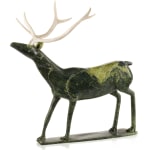-
OSUITOK IPEELEE, R.C.A. (1923-2005) KINNGAIT (CAPE DORSET)
Standing Caribou, mid-late 1980sstone and antler, 17.5 x 16.75 x 5 in (44.5 x 42.5 x 12.7 cm), measurements reflect dimensions with inset antlers, without: 13 x 16.75 x 3.5 in (33 x 42.5 x 8.9 cm)
inscribed and signed, ᑭᒐᐃ (Kinngait) / ᐅᓱᐃᑐ ᐄᐱᓕ".Further images
Looking for examples of caribou sculptures by Osuitok to compare with this gorgeous work, we are reminded of one in particular: a stunning Walking Caribou from c. 1987-88 which we...Looking for examples of caribou sculptures by Osuitok to compare with this gorgeous work, we are reminded of one in particular: a stunning Walking Caribou from c. 1987-88 which we had the privilege to offer in our 13 July 2021 auction (Lot 27). In that catalogue essay we wrote: “Osuitok’s vision – his genius – was his ability to idealize his caribou subjects through stylization. The animal’s forms are simplified here, attenuated there, exaggerated here and there, to create the artist’s vision of the perfect caribou.” The idea of Osuitok’s idealized “vision” of the animal cannot be stressed enough, for it lies at the heart of what makes his finest versions such sublime works of art.
Comparing depictions by Osuitok to those of the Cape Dorset graphic artist Kananginak Pootoogook – the other truly great portrayer of the animal in our opinion – is useful. In his drawings and prints Kananginak took the more “realistic” path, rendering his subjects with sensitivity and grace, and sometimes in unusual poses, but almost always with a high degree of naturalistic detail. [1] Osuitok’s caribou, on the other hand, really are idealizations rather than portraits. We think this is because he was pushing himself to the limits as an artist rather than an observer. We can almost imagine Osuitok asking himself: How thin can I carve those legs before they break? How much can I refine the shape of the neck and head before they become abstract shapes?
The stance of Standing Caribou greatly resembles that of the previously mentioned Walking Caribou, with one difference: its head is raised high, which suggests that the animal has stopped walking and is scenting danger in the air. Here Osuitok has created another masterpiece: exquisitely crafted, beautifully poised, and supremely elegant in every aspect of its sculptural form. In short: a vision.
1. See Hessel, Inuit Art (1998), pl. 25, p. 36; Hessel, Arctic Spirit (2006), cats. 95-96, pp. 106-107; and in many other publications.
Provenance
Collection of John and Joyce Price, Seattle.
Join our mailing list
* denotes required fields
We will process the personal data you have supplied in accordance with our privacy policy (available on request). You can unsubscribe or change your preferences at any time by clicking the link in our emails.










